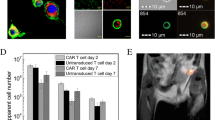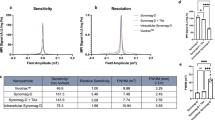Abstract
Purpose
A major hurdle in the advancement of cell-based cancer immunotherapies is the inability to track in vivo therapeutic cell migration. With respect to dendritic cell (DC)-based cancer immunotherapies, this lack of knowledge represents an even greater hurdle as the quantity of tumor-antigen specific DC reaching a secondary lymphoid organ post injection is predictive of the magnitude of the ensuing tumor-specific immune response. We propose fluorine-19 (F-19) cellular magnetic resonance imaging (MRI) as a suitable and non-invasive imaging modality capable of detecting and quantifying DC migration in vivo and thus, serving as a surrogate marker of DC-based immunotherapeutic effectiveness.
Procedures
Murine DC were generated from bone marrow precursors and labeled with a [19F]perfluorocarbon ([19F]PFC)-based cell labeling agent. DC were characterized by viability and phenotyping assessments as well as characterized by ability to induce in vivo tumor-specific immune responses following immunization in a B16-F10 mouse model of melanoma. The in vivo migration of [19F]PFC (PFC)-labeled DC was first compared to control unlabeled DC by microscopy and then measured using F-19 cellular MRI.
Results
Culture conditions were optimized such that > 90 % of DC labeled with PFC without affecting viability, phenotype, and function. This optimization permitted consistent detection of PFC-labeled DC migration using F-19 cellular MRI and resulted in the first successful comparison of in vivo migration between PFC-labeled and control unlabeled therapeutic cells of the same origin. PFC-labeled DC are migration-competent in vivo in a B16-F10 tumor-bearing mouse model.
Conclusions
We report a non-invasive and longitudinal imaging modality capable of detecting and quantifying therapeutic cell migration at both 9.4 and 3 Tesla (T) and suitable for therapeutic cell tracking in a tumor-bearing mouse model. F-19 MRI cell tracking is broadly applicable across disease states and is conducive to clinical translation.






Similar content being viewed by others
References
Gerritsen WR (2012) The evolving role of immunotherapy in prostate cancer. Ann Oncol 23(Suppl 8):viii22–viii27
Schreibelt G, Benitez-Ribas D, Schuurhuis D et al (2010) Commonly used prophylactic vaccines as an alternative for synthetically produced TLR ligands to mature monocyte-derived dendritic cells. Blood 116:564–574
Waldmann TA (2018) Cytokines in cancer immunotherapy. Cold Spring Harb Perspect Biol 10:
Forster R, Braun A, Worbs T (2012) Lymph node homing of T cells and dendritic cells via afferent lymphatics. Trends Immunol 33:271–280
Martin-Fontecha A, Sebastiani S, Hopken UE et al (2003) Regulation of dendritic cell migration to the draining lymph node: impact on T lymphocyte traffic and priming. J Exp Med 198:615–621
Wang B, Sun C, Wang S et al (2018) Mouse dendritic cell migration in abdominal lymph nodes by intraperitoneal administration. Am J Transl Res 10:2859–2867
Scheid E, Major P, Bergeron A et al (2016) Tn-MUC1 DC vaccination of rhesus macaques and a phase I/II trial in patients with nonmetastatic castrate-resistant prostate cancer. Cancer Immunol Res 4:881–892
Blalock LT, Landsberg J, Messmer M et al (2012) Human dendritic cells adenovirally-engineered to express three defined tumor antigens promote broad adaptive and innate immunity. Oncoimmunology 1:287–357
Butterfield LH (2013) Dendritic cells in cancer immunotherapy clinical trials: are we making progress? Front Immunol 4:454
Verdijk P, Aarntzen EH, Lesterhuis WJ et al (2009) Limited amounts of dendritic cells migrate into the T-cell area of lymph nodes but have high immune activating potential in melanoma patients. Clin Cancer Res 15:2531–2540
Ahrens ET, Helfer BM, O’Hanlon CF, Schirda C (2014) Clinical cell therapy imaging using a perfluorocarbon tracer and fluorine-19 MRI. Magn Reson Med 72:1696–1701
Gaudet JM, Ribot EJ, Chen Y et al (2015) Tracking the fate of stem cell implants with fluorine-19 MRI. PLoS One 10:e0118544
Dekaban GA, Hamilton AM, Fink CA et al (2013) Tracking and evaluation of dendritic cell migration by cellular magnetic resonance imaging. Wires Nanomed Nanobi 5:469–483
Rohani R, de Chickera SN, Willert C et al (2011) In vivo cellular MRI of dendritic cell migration using micrometer-sized iron oxide (MPIO) particles. Mol Imaging Biol 13:679–694
Dekaban GA, Snir J, Shrum B et al (2009) Semiquantitation of mouse dendritic cell migration in vivo using cellular MRI. J Immunother 32:240–251
Bonetto F, Srinivas M, Heerschap A et al (2011) A novel 19F agent for detection and quantification of human dendritic cells using magnetic resonance imaging. Int J Cancer 129:365–373
Chapelin F, Capitini CM, Ahrens ET (2018) Fluorine-19 MRI for detection and quantification of immune cell therapy for cancer. J Immunother Cancer 6:105
Fink C, Gaudet JM, Fox MS et al (2018) 19F-perfluorocarbon-labeled human peripheral blood mononuclear cells can be detected in vivo using clinical MRI parameters in a therapeutic cell setting. Sci Rep 8:590
Inaba K, Inaba M, Romani N et al (1992) Generation of large numbers of dendritic cells from mouse bone marrow cultures supplemented with granulocyte/macrophage colony-stimulating factor. J Exp Med 176:1693–1702
de Chickera S, Willert C, Mallet C et al (2012) Cellular MRI as a suitable, sensitive non-invasive modality for correlating in vivo migratory efficiencies of different dendritic cell populations with subsequent immunological outcomes. Int Immunol 24:29–41
Sethumadhavan S, Silva M, Philbrook P et al (2017) Hypoxia and hypoxia-inducible factor (HIF) downregulate antigen-presenting MHC class I molecules limiting tumor cell recognition by T cells. PLoS One 12:e0187314
Srinivas M, Boehm-Sturm P, Figdor CG et al (2012) Labeling cells for in vivo tracking using 19F MRI. Biomaterials 33:8830–8840
Taylor AJ, Granwehr J, Lesbats C et al (2016) Probe-specific procedure to estimate sensitivity and detection limits for 19F magnetic resonance imaging. PLoS One 11:e0163704
Srinivas M, Morel PA, Ernst LA et al (2007) Fluorine-19 MRI for visualization and quantification of cell migration in a diabetes model. Magn Reson Med 58:725–734
Hitchens TK, Ye Q, Eytan DF et al (2011) 19F MRI detection of acute allograft rejection with in vivo perfluorocarbon labeling of immune cells. Magn Reson Med 65:1144–1153
Makela AV, Foster PJ (2018) Pre-clinical 19F MRI cell tracking at 3 Tesla. Magma
Long CM, van Laarhoven HW, Bulte JW, Levitsky HI (2009) Magnetovaccination as a novel method to assess and quantify dendritic cell tumor antigen capture and delivery to lymph nodes. Cancer Res 69:3180–3187
Srinivas M, Tel J, Schreibelt G et al (2015) PLGA-encapsulated perfluorocarbon nanoparticles for simultaneous visualization of distinct cell populations by 19F MRI. Nanomedicine (London) 10:2339–2348
Bouchlaka MN, Ludwig KD, Gordon JW et al (2016) 19F-MRI for monitoring human NK cells in vivo. Oncoimmunology 5:e1143996
Sato N, Wu H, Asiedu KO et al (2015) 89Zr-oxine complex PET cell imaging in monitoring cell-based therapies. Radiology 275:490–500
Wimmers F, Schreibelt G, Skold AE et al (2014) Paradigm shift in dendritic cell-based immunotherapy: from in vitro generated monocyte-derived DCs to naturally circulating DC subsets. Front Immunol 5:165
Dhodapkar MV, Steinman RM, Krasovsky J et al (2001) Antigen-specific inhibition of effector T cell function in humans after injection of immature dendritic cells. J Exp Med 193:233–238
de Chickera SN, Snir J, Willert C et al (2011) Labelling dendritic cells with SPIO has implications for their subsequent in vivo migration as assessed with cellular MRI. Contrast Media Mol I 6:314–327
Ahrens ET, Bulte JW (2013) Tracking immune cells in vivo using magnetic resonance imaging. Nat Rev Immunol 13:755–763
Vuylsteke RJ, Molenkamp BG, Gietema HA et al (2004) Local administration of granulocyte/macrophage colony-stimulating factor increases the number and activation state of dendritic cells in the sentinel lymph node of early-stage melanoma. Cancer Res 64:8456–8460
Takayama K, Yokozeki H, Ghoreishi M et al (1999) IL-4 inhibits the migration of human Langerhans cells through the downregulation of TNF receptor II expression. J Invest Dermatol 113:541–546
Gonzales C, Yoshihara HA, Dilek N et al (2016) In vivo detection and tracking of T cells in various organs in a melanoma tumor model by 19F-fluorine MRS/MRI. PLoS One 11:e0164557
Castro O, Nesbitt AE, Lyles D (1984) Effect of a perfluorocarbon emulsion (Fluosol-DA) on reticuloendothelial system clearance function. Am J Hematol 16:15–21
Dunn GP, Old LJ, Schreiber RD (2004) The immunobiology of cancer immunosurveillance and immunoediting. Immunity 21:137–148
Srinivas M, Turner MS, Janjic JM et al (2009) In vivo cytometry of antigen-specific T cells using 19F MRI. Magn Reson Med 62:747–753
Dashti A, Ebrahimi M, Hadjati J et al (2016) Dendritic cell based immunotherapy using tumor stem cells mediates potent antitumor immune responses. Cancer Lett 374:175–185
Damo M, Wilson DS, Simeoni E, Hubbell JA (2015) TLR-3 stimulation improves anti-tumor immunity elicited by dendritic cell exosome-based vaccines in a murine model of melanoma. Sci Rep 5:17622
Zhang Y, Liu X, Wang R et al (2018) Comparison of fusion protein and DC vaccine in inhibition of mouse B16F10 melanoma tumor. Biomed Pharmacother 97:784–792
Jonuleit H, Kuhn U, Muller G et al (1997) Pro-inflammatory cytokines and prostaglandins induce maturation of potent immunostimulatory dendritic cells under fetal calf serum-free conditions. Eur J Immunol 27:3135–3142
Melero I, Gaudernack G, Gerritsen W et al (2014) Therapeutic vaccines for cancer: an overview of clinical trials. Nat Rev Clin Oncol 11:509–524
Farhood B, Najafi M, Mortezaee K (2019) CD8(+) cytotoxic T lymphocytes in cancer immunotherapy: A review. J Cell Physiol 234:8509–8521
Steitz J, Bruck J, Steinbrink K et al (2000) Genetic immunization of mice with human tyrosinase-related protein 2: implications for the immunotherapy of melanoma. Int J Cancer 86:89–94
Palazon A, Tyrakis PA, Macias D et al (2017) An HIF-1alpha/VEGF-A axis in cytotoxic T cells regulates tumor progression. Cancer Cell 32:669–683
Boudewijns S, Bloemendal M, Gerritsen WR et al (2016) Dendritic cell vaccination in melanoma patients: from promising results to future perspectives. Hum Vacc Immunother 12:2523–2528
Hooijkaas AI, Gadiot J, van der Valk M et al (2012) Targeting BRAFV600E in an inducible murine model of melanoma. Am J Pathol 181:785-794
Acknowledgments
We thank Dr. Amanda Hamilton and Dr. Kristin Chadwick for technical expertise and Dr. Thomas Craig Meagher for assistance with manuscript reviewing.
Funding
This research was supported by a grant from the Ontario Institute for Cancer Research.
Author information
Authors and Affiliations
Corresponding author
Ethics declarations
Conflict of Interest
The authors declare that they have no conflict of interest.
Additional information
Publisher’s Note
Springer Nature remains neutral with regard to jurisdictional claims in published maps and institutional affiliations.
Rights and permissions
About this article
Cite this article
Fink, C., Smith, M., Gaudet, J.M. et al. Fluorine-19 Cellular MRI Detection of In Vivo Dendritic Cell Migration and Subsequent Induction of Tumor Antigen-Specific Immunotherapeutic Response. Mol Imaging Biol 22, 549–561 (2020). https://doi.org/10.1007/s11307-019-01393-8
Published:
Issue Date:
DOI: https://doi.org/10.1007/s11307-019-01393-8




